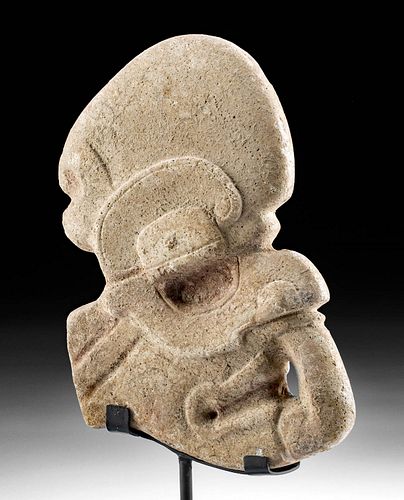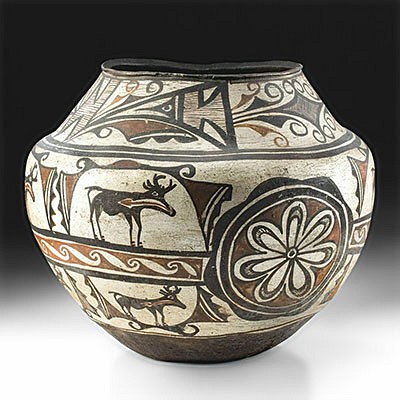Veracruz Stone Hacha - Abstract Face w/ Cinnabar
Lot 102
About Seller
Artemis Fine Arts
686 S Taylor Ave, Ste 106
Louisville, CO 80027
United States
Selling antiquities, ancient and ethnographic art online since 1993, Artemis Gallery specializes in Classical Antiquities (Egyptian, Greek, Roman, Near Eastern), Asian, Pre-Columbian, African / Tribal / Oceanographic art. Our extensive inventory includes pottery, stone, metal, wood, glass and textil...Read more
Estimate:
$5,500 - $8,250
Absentee vs Live bid
Two ways to bid:
- Leave a max absentee bid and the platform will bid on your behalf up to your maximum bid during the live auction.
- Bid live during the auction and your bids will be submitted real-time to the auctioneer.
Bid Increments
| Price | Bid Increment |
|---|---|
| $0 | $25 |
| $300 | $50 |
| $1,000 | $100 |
| $2,000 | $250 |
| $5,000 | $500 |
| $10,000 | $1,000 |
| $20,000 | $2,500 |
| $50,000 | $5,000 |
| $100,000 | $10,000 |
| $200,000 | $20,000 |
About Auction
By Artemis Fine Arts
Nov 18, 2021
Set Reminder
2021-11-18 10:00:00
2021-11-18 10:00:00
America/New_York
Bidsquare
Bidsquare : Art & Artifacts of North America
https://www.bidsquare.com/auctions/artemis-gallery/art-artifacts-of-north-america-7894
Join us for a special auction not to be missed! Collectible Native American art from antiquity to mid-20th century, Spanish Colonial, Latin American, Pre-Columbian, fine & folk art, American frontier items, fossils, and much more! Artemis Fine Arts info@artemisgallery.com
Join us for a special auction not to be missed! Collectible Native American art from antiquity to mid-20th century, Spanish Colonial, Latin American, Pre-Columbian, fine & folk art, American frontier items, fossils, and much more! Artemis Fine Arts info@artemisgallery.com
- Lot Description
Pre-Columbian, Gulf Coast of Mexico, Veracruz (Vera Cruz) culture, ca. 5th to 7th century CE. A fabulous example of a hand-carved stone hacha depicting an abstract anthropomorphic face, perhaps that of an elderly shaman. The three-dimensional countenance exhibits expertly sculpted details including recessed semicircular eyes beneath a low brow, drooping cheek bones, an aquiline nose with bulbous nostrils, puffy lips with circular corners, and a prominent chin fronted with the curve of a J-shaped nose ornament. The thick brows rise above the face and rest beneath a trapezoidal, axe-shaped headdress bearing a bowtie-shaped groove along the verso. Areas of the wheat-hued stone are accentuated with rubbed cinnabar in hues of maroon and crimson to create a captivating presentation. Size: 5.6" L x 1.375" W x 8.5" H (14.2 cm x 3.5 cm x 21.6 cm); 10.6" H (26.9 cm) on included custom stand.
Hachas were associated with the ritual Mesoamerican ballgame, though they were not actually part of the player's equipment. Instead, these were worn during ritualistic ceremonies related to the game. The name stems from the fact that they were believed to be axe-heads; hence the term hacha (Spanish for axe). Having studied ceramic figures and imagery on stone carvings, some scholars have proposed that hachas were meant to be attached to yugos (yokes). Others have suggested that some hachas likely served as ballcourt markers.
Cf. The Metropolitan Museum of Art, accession number 1979.206.371; The British Museum, museum number Am1849,0629.3; and The Los Angeles County Museum of Art, accession number K6893
Another example hammered for EUR 39.900 ($46,950.29) at Sotheby's, Paris (sale PF1340, March 22, 2013, lot 30)
This piece has been searched against the Art Loss Register database and has been cleared. The Art Loss Register maintains the world's largest database of stolen art, collectibles, and antiques.
Provenance: private Superior, Colorado, USA collection; ex-private Chicago, Illinois, USA collection, before 1974
All items legal to buy/sell under U.S. Statute covering cultural patrimony Code 2600, CHAPTER 14, and are guaranteed to be as described or your money back.
A Certificate of Authenticity will accompany all winning bids.
PLEASE NOTE: Due to recent increases of shipments being seized by Australian & German customs (even for items with pre-UNESCO provenance), we will no longer ship most antiquities and ancient Chinese art to Australia & Germany. For categories of items that are acceptable to ship to Australia or Germany, please contact us directly or work with your local customs brokerage firm.
Display stands not described as included/custom in the item description are for photography purposes only and will not be included with the item upon shipping.
#167846Minor nicks and pitting across surfaces, with fading to some red cinnabar details, and light encrustations, otherwise intact and near-choice. Wonderful root marks and earthen deposits throughout, with great preservation to overall form, and nice remains of cinnabar within some details.Condition
- Shipping Info
-
All shipping is handled in-house for your convenience. Your invoice from Artemis Gallery will include shipping calculation instructions. If in doubt, please inquire BEFORE bidding for estimated shipping costs for individual items.
-
- Buyer's Premium



 EUR
EUR CAD
CAD AUD
AUD GBP
GBP MXN
MXN HKD
HKD CNY
CNY MYR
MYR SEK
SEK SGD
SGD CHF
CHF THB
THB














